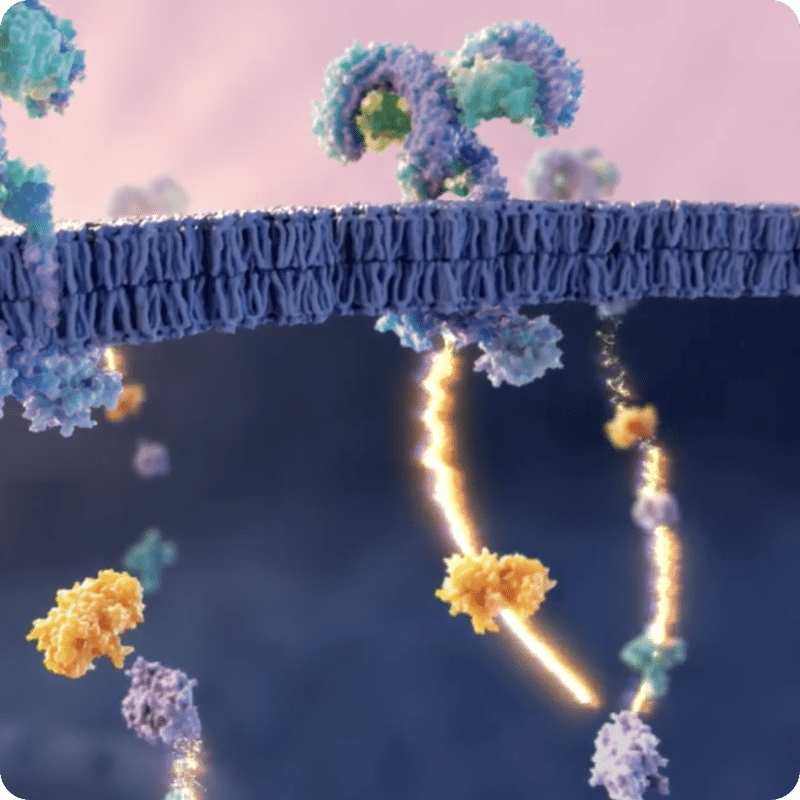Reaction Biology’s Assay Formats
HotSpot™ Kinase Screen Using the Gold Standard Radiometric Assay
The HotSpot™ Kinase Screen uses a radiometric assay format, which directly measures kinase activity by detecting the incorporation of radioactive phosphate into the substrate.
Here’s what sets it apart:
- Direct Measurement of Kinase Activity: Radiometric assays are widely recognised as gold standard to test kinase activity as they are a highly validated method that detects phosphorylated substrate products, without the use of modified substrates, coupling enzymes, or detection antibodies.
- Physiological Relevance: We can run this assay using physiologically relevant concentrations of ATP (1mM), in addition to 1μM, 10μM, or apparent ATP-Km up to 100μM. This flexibility ensures that the assay conditions closely mimic biological environments, providing more accurate insights into kinase activity.
HotSpot™ Kinase Screen
Test kinase activity at physiological ATP levels with our best-in-class radiometric assay
Limited Slots Available! Hurry and secure your place in our next screening schedule.
- Universal Applicability: Radiometric assays are not kinase-dependent and can be applied to any kinase, representing a truly universal assay that offers consistent and robust results with low background signal. With over 20 years of experience, we have assembled a vast collection of over 700 human kinases, ensuring you obtain a comprehensive assessment of your compound’s selectivity.
- Sensitive to Substrate-Specific Inhibitors: The HotSpot assay is highly sensitive to inhibitors that specifically target the substrate interaction site, providing detailed insights into inhibitor specificity.
- Accommodates protein substrates and peptides: Unlike fluorescence assays that require labelling, which can alter the natural function of proteins or peptides, radiometric assays do not require any labelling or modification. This flexibility allows them to accommodate wide range of substrates for kinase activity studies.
Who is the Radiometric Assay ideal for?
- Researchers seeking precise and high-quality data to confirm suspected kinase activity.
- Research programs focused on high-throughput kinase profiling, whether calculating selectivity indices or conducting off-target analysis. Our extensive human kinome collection, including more that 700 kinase targets, and our well-established screening capabilities capable of processing more than 23,000 data points per day, provide a comprehensive overview of your compound’s effects.
- Studies requiring the evaluation of kinase activity at ATP concentrations that closely mimic physiological conditions.
Test On-target & Off-Target Kinase Profiling Based on the industry's largest human kinome collection
ADP-Glo™ – Luminescence Assay
ADP-Glo offers a fast and efficient approach to measuring kinase activity through a luminescence-based format. The assay detects the production of ADP via a luminescent signal, providing an indirect but sensitive measure of kinase activity.
Here’s what sets it apart:
- Large scale: Luminescence technology is fast and economical making it well-suited for preliminary high-throughput screening where efficiency is key. At Reaction Biology we can test up to 3,500 data points or more than 300 10-point IC50 curves a day using ADP-Glo assay.
- Sensitive to Substrate-Specific Inhibitors: Like radiometric assays, ADP-Glo – based assay is also sensitive to inhibitors that target specific substrate interactions, however it may be suboptimal for testing kinases with low enzymatic activity and may need counter assays for compounds that interfere with ADP-Glo detection system.
- Versatile Kinase Profiling: The ADP-Glo assay is excellent for validating in-house data and expanding upon initial findings to include a broader range of kinase targets, with over 200 kinases currently available for screening.
Reaction Biology Presents:
ADP-Glo™ Kinase Assay
Who is the Luminescence Assay ideal for?
- Researchers looking for rapid assessment of kinase activity.
- Preliminary or early-stage screening of multiple kinase targets.

Table comparing radiometric filter binding assay and luminescence assay
Choosing the Right Assay for your Research
Both the HotSpot Kinase Screen using Radiometric Assay format and the ADP-Glo Luminescence Assay offer robust platforms for kinase activity evaluation, each with its unique strengths. Radiometric assays are your go-to choice when accurate, direct measurement of kinase activity is paramount, especially when working with physiological ATP levels or with kinases with low enzymatic activity. On the other hand, an ADP-Glo-based assay could be your assay of choice if you are looking to rapidly obtain preliminary results on your kinase activity.
Why Work with Reaction Biology
Working with Reaction Biology allows you to leverage the largest collection of human kinase targets. If you have ADP-Glo data you generated in house and you are looking to validate them or test new targets, our team is able to process more than 300 10-point IC50 curves per day. Most importantly, we are the only service provider who is able to offer both luminescence-based and gold standard radiometric activity-based assay formats at your local RBC labs allowing you to seamlessly transition from early-stage ADP-Glo findings to advanced data from radiometric assays. Our HotSpot is the best in class kinase screen platform which uses a superior radiometric filter binding assay format that further reduces signal noise and minimizes false positive and negatives. We can run radiometric screens at high throughput and process more than 23,000 data points per day and we never compromise on quality, giving you the confidence you need to select your lead drug candidate.
Contact our team and let´s discover together!



